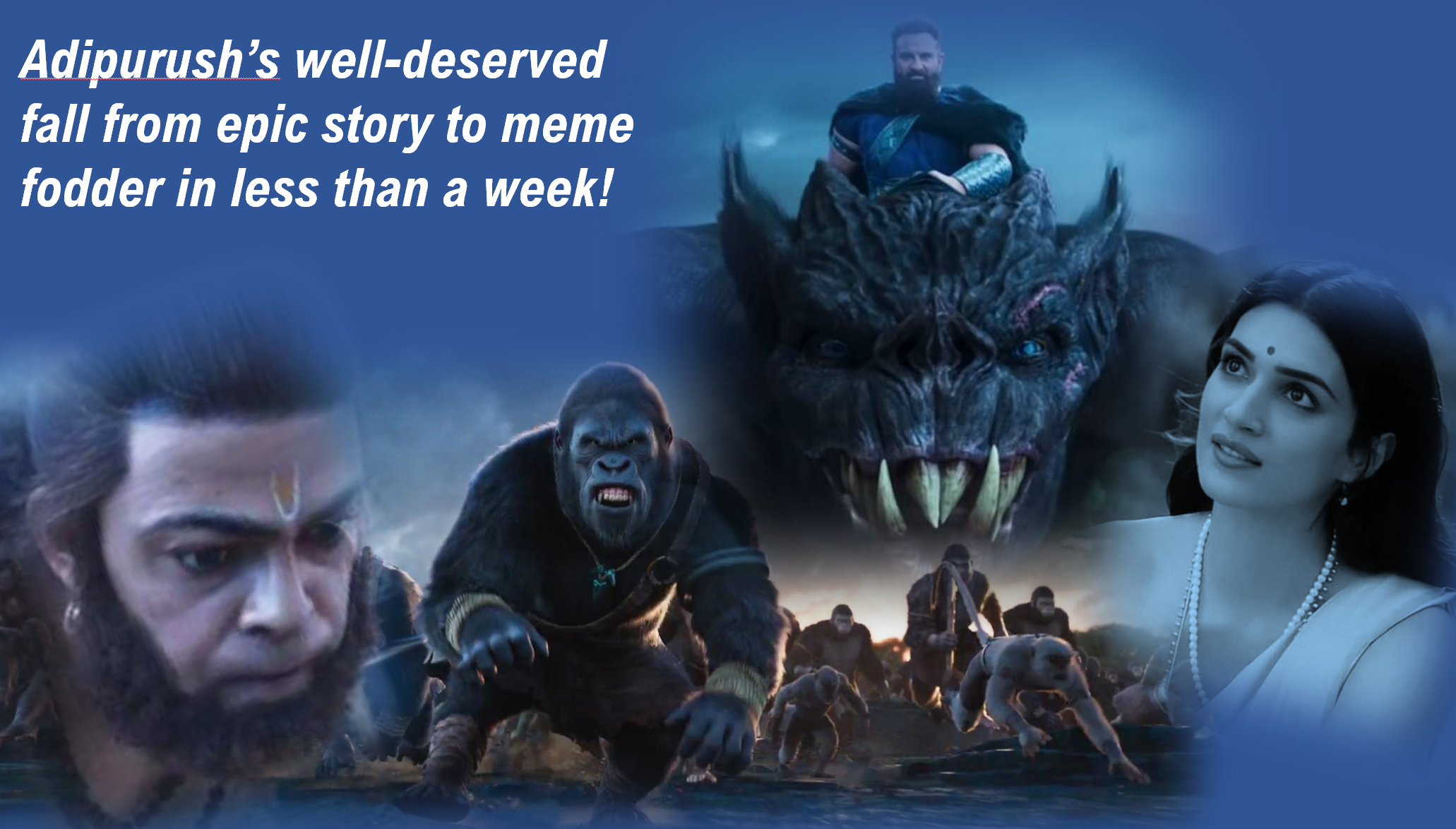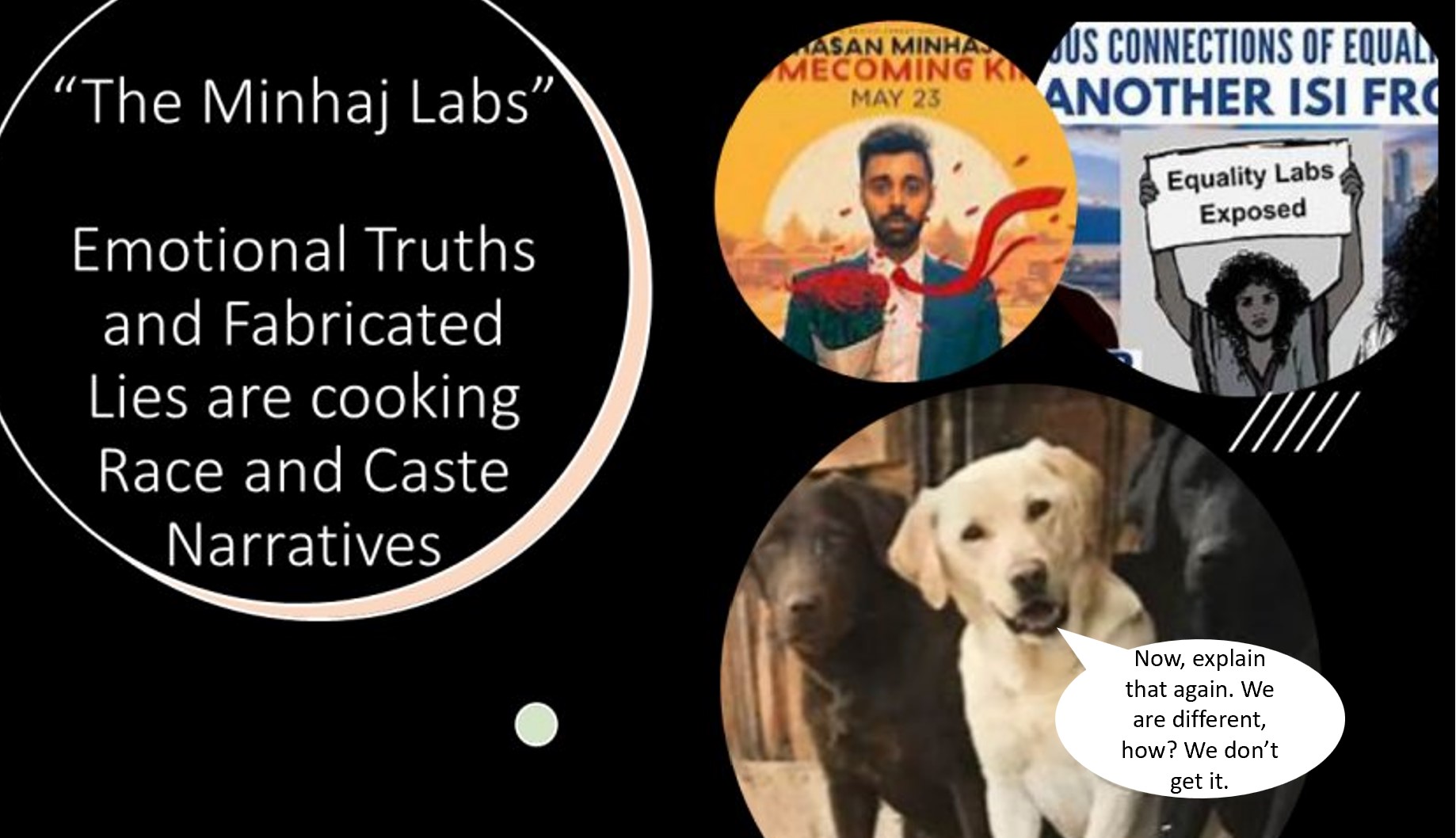It’s been a week since the mainstream headlines and the social media trends in India are being dominated by Bollywood’s maligning of a revered Hindu epic of Ramayana via a recently released major motion picture, ‘Adipurush.’ Now Ramayana is one story that has found multiple renditions through various art forms, including poetry, hymns, daily recitals, and even street plays called ‘Ramleela,’ which have always been enjoyed by millions across India. A popular trope in Bollywood expounds how it is extremely difficult to lose money on any content based on Ramayana and Mahabharata. And yet ‘Adipurush’ turned out to be a calamity[1], despite the Bollywood audience being openly supportive of Hindu content. It would be interesting to scratch the surface and look at a few reasons.
Irreverent Portrayal
Almost all the main characters featured in ‘Adipurush’ are considered holy forms of God in Hinduism. As a civilization, Hindus went through centuries of struggle to re-establish a Lord Rama temple at his birthplace in Ayodhya, which was earlier destroyed and defiled by the Mughal barbarians. So, to expect the same audience to welcome a caricature picturization of their revered deities in a Bollywood film was a big ask. Though people did throng the theaters on the first weekend, a bad word-of-mouth publicity ensured poor box-office collections for every subsequent show, besides triggering calls of protest and boycott[2].
Corny dialogues
Again, it was the same conundrum for the masses, wherein their Gods were shown mouthing inane stereotype chitter-chatter that would look commonplace in a typical C-grade Bollywood potboiler. This alone sparked a huge furor, as conversations between Lord Rama and Lord Hanuman form the biggest part of various Hindu daily holy recitals, including the Hanuman Chalisa and the Ramcharitmanas. In their quest for generating viral catchphrases, the makers of ‘Adipurush’ pushed in punchlines based on popular memes and the current street lingo, further repelling an already revulsed audience.
Wrong Picturization
Almost everything shown in ‘Adipurush’ flew in the face of the typically popular imagery of the epic, established according to the descriptions provided within the Ramayana text. So even though Ravan is the main antagonist, his movie look of a deranged uncivilized 16th-century Mughal savage does no justice to his antecedents of being a staunch Lord Shiva devotee and a learned King gone wrong. Likewise, his kingdom of Lanka is chronicled in various versions as a city of gold, while ‘Adipurush’ presents it as some blackish hellhole. And the less said about Ravan feeding red meat to his pet, the better. Likewise, Lord Hanuman’s look without a mustache – contrary to his popular image, evoked ire everywhere, as it gave Him a slight mullah vibe.
How could the Producers go so wrong?
It all starts with your intention. And with ‘Adipurush,’ it is largely evident that the Producers never began with the honest intention of retelling the grand story of our glorious forefathers to the present generation, using all the latest VFX technology at their disposal. Instead, it looked like a typical ivory tower Bolly-project assembled on the go, packaged to profit from the current growing taste of our audience for grounded Indic content. And the package was topped with some Hollywood-type garnish to take it across the world, cashing on the goodwill created by SS Rajamouli’s giant killer ‘RRR.’
Too bad that the garnish dominated the flavor so much that the original story offering went sour. Right from the title, ‘Adipurush’ looks like a take on Hollywood superhero films. Loosely translated, ‘Adipurush’ means Original Man or Primordial Man or Originator – quite matching the popular Holly-format of Super Man, Bat Man, Iron Man, etc. And it doesn’t just stop here; Ravan’s Lanka looks like a straight lift from Thor’s Asgard, and battle scenes are modeled on Avengers, as alleged widely[3]. Lord Rama’s army of monkeys is shown to have gorillas and chimpanzees – species that have never existed in these parts of the world ever. Was that a liftoff from the popular franchise of ‘The Planet of Apes’? Did the Producers simply purchase the standard wireframe elements available in the animation open market and just added the skins without verifying their fit in the story? Questions abound… Even the banal exchange of trite dialogues seems like an overt attempt to replicate the cool jibes and repartees between the various Avenger characters. All in all, the studio’s directive for making the movie seems to be pretty clear now: take the basic storyline of Ramayana, tone down and secularize the consecrated and straitjacket it through all the popular tropes of Hollywood superhero flicks and what have you…
Obviously, the intention was never honest, and that is evident in the postmortem interviews of the Producers and the writers, wherein they are braving it out as this was never really a retelling of Ramayana but simply their modern take on the epic. Why, they had even baked in some easy deniability – right from the start, with the names of their characters. Yes, Lord Rama is always referred to here as Raghav, Laxmana as Shesha, and Sita as Janaki.
Should Gods be a part of cinematic universes?
The moot question remains: should cinematic liberties be taken for character arcs that involve traditional Gods and demons? How much can you really stretch a storyline that involves a revered deity? Now this might be new for Indian cinema, but Hollywood has gone whole hog in this area by incorporating almost the entire pantheon of Norse, Greek, and Egyptian Gods[4].
Obviously, the most prominent gods in the Marvel Cinematic Universe (MCU) are the ones from Norse mythology, including Thor, Odin, Loki, Hela, Bor, Heimdall, Frigga, Sif, and Tyr. These beings self-identify as Gods and routinely make their presence felt in the Thor and Avenger franchises.
The Egyptian Gods have recently debuted in the MCU with the new Disney+ series, ‘Moon Knight,’ featuring prominent Egyptian gods in ‘Khonshu’ and ‘Ammit.’ The Greek Gods had traditionally stayed restricted to Marvel Comics only, but that changed with Russell Crowe’s ‘Zeus’ in 2022’s ‘Thor: Love and Thunder.’ The Greek Gods have, however, gotten their extended silver screen run with the DC Extended Universe (DCEU) with a lineup of movies like ‘Shazam,’ ‘Wonder Woman’ and ‘Justice League.’
So why is it that dollops of unchallenged and wanton cinematic liberties got taken for the Norse, Greek, and Egyptian heavenly beings but not with the Hindu pantheon? The answer is very simple: none of the believers of the original Norse, Greek, and Egyptian faith system exist anymore. All of them were apportioned and assimilated centuries ago into the two Abrahamic denominations, who pride themselves on branding every God other than theirs as a false entity. But the same is not the case with the Hindus, who are still in deep embrace with the same ethos and principles of the Sanatana (eternal) dharma that have existed since time immemorial. Waves after waves of Abrahamic invaders have not been able to make a dent in the Hindu belief system, who still consider Ramayana and Mahabharata as their ‘itihaasa’ – a living chronicle of their ancestors, and not as some mythology. Naturally, any liberty with their story could be tantamount to hurting the faith of billions.
Despite that, a host of Hindu Gods have found space within the Marvel and DC Universe. ‘Dr. Strange’[5], a Marvel hit, had so many elements of Hinduism, right from the Third Eye to the references to Kalchakra, Shamballa, and Atharvaveda[6]. In fact, Rama and Ravana routinely found a place in DC Comics as superhero characters with a slight similarity in original stories but different character arcs. Why, even the triumvirate of Brahma, Vishnu, and Shiva form inspired characters in many popular comic strips, but the stories and character arcs are completely different from what exists in Hindu scriptures[7]. At best, they have a similar origin story. Besides, they are never marketed as depicting the original Hindu tales.
It is not just the superhero universes that carry references to the Hindu pantheon. James Cameron’s sci-fi ‘Avatar’ is quite open about its Indic association, with its Sanskrit title and characters with blue skin, candidly conceding how “he didn’t want to reference the Hindu religion so closely, but the subconscious association was interesting”[8]. Ditto for the Doctor Manhattan character from ‘Watchmen’ reflecting the quintessence of Lord Krishna right from his blue color to his hyperconscious powers and his quotes from Bhagwad Gita after the detonation of the atomic bomb.
Besides, it’s not that Bollywood has never attempted a retelling of the epics before. The Telugu film industry is actually famous for its near-perfect portrayal of various characters from Hindu epics. The very act of moviemaking in India began by portraying religious stories and sacred characters. Later branded as costume dramas, these religious films were a steady staple till the eighties. Just to indicate their popularity and following, a 1975 low-budget religious movie ‘Jai Santoshi Maa’ almost matched the box-office collections of the then-priciest blockbuster, ‘Sholay.’
Outside of the silver screen purview, too, alternate retellings of the scriptures were never looked down upon. Bhāsa, one of the earliest and most celebrated Indian playwrights in Sanskrit, predating Kalidasa, has thirteen plays that went about elucidating the point of view of the antagonist characters from our epics[9]. Indeed, he made Duryodhana, Karna, and Kaikeyi the central characters of his plays. Even today, his plays are routinely performed in temples in Kerala as a part of their Koddiyattam heritage. His translated works have found favor in stories and play in various languages, the only probable reason being that none of Bhāsa’s story arcs deride the sanctity of the main characters, nor do they try to justify any of the character’s vile acts.
Ramayana on the small screen
No discussion on Indian epics is complete without the statutory appraisal of the TV series made by Ramanand Sagar for the Doordarshan channel in 1987. Himself an accomplished Bollywood producer, Ramanand Sagar had always dreamt of recreating Ramayana on the small screen and went through a prolonged, torturous squeeze by the bureaucrats and the government ministers before his magnum opus came to light. His entire family was involved in the production process, and even today, the Sagar boys believe that Ramanand Sagar was born to rewrite the Ramayana. “He rewrote Ramayana for today’s electronic era. With every period, Ramayana has to be revived for mankind,” declares his son, Prem Sagar[10]. Naturally, the series was a huge hit on TV then and an even bigger hit when it was re-released during the Covid lockdown, creating a world record in viewership.
Now, this is where the sincerity of purpose comes into the picture when undertaking projects of civilizational importance, like the Ramayana. When Ramanand Sagar got tired of all the rejection from Doordarshan, he almost decided to give up the project, and that’s when a young sadhu randomly visited his office, seeking his audience. He proclaimed that he was sent by his guru in the Himalayas to deliver a message. And then the sadhu proceeded to lambast Ramanand Sagar for his ego and impatience. Who are you to say I will not do this and that, he thundered. How can you give up on Ramayana? Heavens has chosen you for this work. Just do your job and come back, he rumbled and left[11]. Long story short, Ramanand Sagar overcame all obstacles and delivered a cult classic that made waves across the world. Can the makers of ‘Adipurush’ claim to possess a similarly higher purpose? Or was it just chasing big bucks that took precedence over hurting the sentiments of a billion believers?
When Hollywood’s ‘X-Men Apocalypse’ came to India, the makers had the sensibility to cut out a portion of the villain Apocalypse’s dialogue wherein he declares how he has been “called many things over many lifetimes; Ra, Yahweh, Krishna.” Couldn’t Bollywood and ‘Adipurush’ also show some sensitivity while depicting Lord Rama?
All said and done, the fact remains that maybe we don’t need a changed Ramayana for our new generation; maybe we just need Ramayana to change our new generation!!!
Citations
[1] Sikarwar, Ayushi. 2022. “Big Budget Haatim”: Prabhas as Rama disappoints fans, makers get trolled for poor VFX in Adipurush.” NewsroomPost. https://newsroompost.com/entertainment/big-budget-haatim-prabhas-as-rama-disappoints-fans-makers-get-trolled-for-poor-vfx-in-adipurush/5195516.html
[2] Mehrotra, Vani. 2023. “Kathmandu, Pokhara ban screening of Hindi movies amid ‘Adipurush’ dialogue row.” India Today. https://www.indiatoday.in/india/story/adipurush-row-nepal-bans-hindi-movies-makers-write-to-kathmandu-mayor-2394789-2023-06-19
[3] Team TOI. 2022. “Netizens troll ‘Adipurush’ yet again for ‘COPYING’ battle scene from ‘The Avengers’; netizens say ‘This movie is inspired by everything except Ramayan.’” TOI. https://timesofindia.indiatimes.com/videos/etimes/bollywood/netizens-troll-adipurush-yet-again-for-copying-battle-scene-from-the-avengers-netizens-say-this-movie-is-inspired-by-everything-except-ramayan/videoshow/101155800.cms?from=mdr
[4] Singh, Angad. 2022. “All The Gods Teased In The MCU So Far.” FandomWire, April 12, 2022. https://fandomwire.com/all-the-gods-teased-in-the-mcu-so-far/
[5] KOIMOI. 2020. “Avengers: Endgame Trivia #112: Doctor Strange Shares THIS Striking Similarity With Lord Shiva.” Koimoi. https://www.koimoi.com/hollywood-news/avengers-endgame-trivia-112-doctor-strange-shares-this-striking-similarity-with-lord-shiva/
[6] FANDOM. 2016. “’Doctor Strange’s Magical and Mystical Roots in Hindu Mythology.” Fandom, November 30, 2016. https://www.fandom.com/articles/doctor-strange-magical-mystical-roots-hindu-mythology
[7] Mishra, Gargi. 2022. “Powerful Marvel Characters That Took Direct Inspiration From Hindu Gods.” FandomWire. https://fandomwire.com/powerful-marvel-characters-that-took-direct-inspiration-from-hindu-gods/
[8] Pereira, Karen. 2022. “Avatar to Star Wars: Hollywood movies inspired by Indian mythology.” Times of India. https://timesofindia.indiatimes.com/entertainment/english/web-stories/avatar-to-star-wars-hollywood-movies-inspired-by-indian-mythology/photostory/95985811.cms?from=mdr
[9] Sahapedia. 2022. “Bhasa.” Bhasa. https://www.sahapedia.org/bhasa?fbclid=IwAR05f_bJQ0A38DMswghcYjrvXaL6XSu7xXE1u8IytX7b8_jgRl3DZ6cHDvM
[10] India Today. 2022. “IT.” IT. https://www.indiatoday.in/television/soaps/story/throwback-thursday-ramanand-sagar-s-ramayan-is-the-most-expensive-mythological-show-of-its-time-1659941-2020-03-26?fbclid=IwAR05f_bJQ0A38DMswghcYjrvXaL6XSu7xXE1u8IytX7b8_jgRl3DZ6cHDvM
[11] Scroll. 2022. “Scroll.” Scroll. https://scroll.in/reel/946733/how-a-cafe-owner-and-rajiv-gandhi-contributed-to-ramanand-sagars-blockbuster-tv-show-ramayan?fbclid=IwAR0EvXgdW27JgQFCWL5Xhg9E4oq3OvoYG8lADfdbu2Ky-Aga3S5RQHaPPgo







